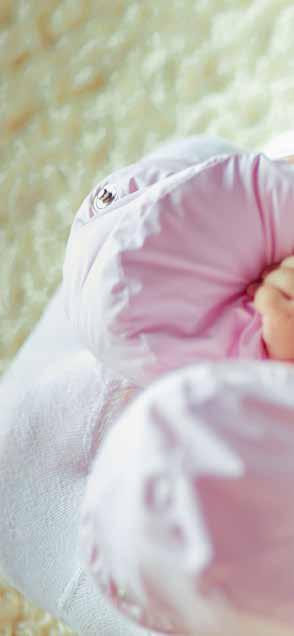
4 minute read
When Does Your Baby Need a Pacifier?
WHEN DOES BABY NEED A PACIFIER?
The benefits of pacifiers are well known to include soothing and comforting babies. That said, there are a few potential side issues associated with them.
Babies have an instinct to suck without receiving milk and this reflex is incredibly soothing for them. You may have noticed your little one sucking a thumb on the ultrasound or you might even see them attempting to put a finger or thumb in their mouth as a newborn.
A pacifier can be given to your baby as something safe to suck for comfort. As a parent, it’s important to know that there is no right or wrong choice. Some people hate pacifiers, others love them. Some babies refuse them, others never want to give them up! It’s a matter of personal preference - but it’s good to understand both the positive and negative effects so you can make the decision that’s best for your child.
WHAT ARE THE BENEFITS OF A PACIFIER?
Pacifiers have a number of obvious benefits in helping babies feel relaxed and helping you keep things manageable as a parent. However, let’s take a look at some of the more specific ways a pacifier can be useful. These are:
Bedtime routine
Pacifiers can be very useful for reducing how much your baby cries. This is particularly good if your baby needs help calming down or falling asleep at bedtime. It also encourages your little one to self-settle by providing them with enough comfort to be able to go to sleep alone.
Emergencies
Pacifiers can also come in handy as a distraction in an emergency. Every parent has moments where they need a way to immediately help their crying baby, whether it’s over sore gums from teething, loud noise in a public place or even during immunisations. In these tricky situations, pacifiers can be a great tool for parents to rely on to help their little one feel safe and soothed.
Bottle feeding and settling
If your baby feeds from a bottle, they will likely need to suck for longer than the milk lasts in the bottle. Giving your child a pacifier when the bottle is empty can help them feel more settled after their feed. Once they feel this, your baby will likely spit the pacifier out, so if this does happen, resist the temptation to put it back in! Only put it back in if they truly need it.
WHEN TO START
Pacifiers can be given any time from birth up to toddler age. Those who are bottle fed can start using a pacifier earlier than those who are breastfed. If you are breastfeeding your little one, only give a pacifier once your baby has learnt to latch correctly and nursing is well-established between you. Be mindful not to use the pacifier too close to feeding time as this can confuse your baby and cause issues with the amount of milk they are willing to drink. Whatever timeline you choose to follow, just remember that every baby is unique and will adapt in their own way to this new experience you’ve introduced to them!
Important to remember
Make sure to have several of the same types of pacifiers on hand as they tend to be misplaced or get dirty easily! Always take care to clean and sanitise your child’s pacifiers regularly to make sure bacteria doesn’t grow.

OTHER COMFORTERS
The natural sucking reflex disappears around three months as your child’s awareness increases. This means by four or five months old, your baby might have other ways to calm and ground themselves. These can include rubbing cloth tags, sucking knots on toys, patting or rubbing their head on the mattress, turning their head from side to side or cuddling a soft toy. It’s a good idea to foster these alternative methods of soothing so that giving up the pacifier is easier.
WHAT TO LOOK OUT FOR
There are many benefits to sucking a pacifier, but there are some potential side effects that are important to be aware of. Spending lots of time sucking on one can raise the likelihood of ear infections due to the bacteria it adds to your baby’s saliva. For older children who still use a pacifier during the day, it can interfere with the way they form words and sounds, leading to speech development issues.
SAYING GOODBYE
The day will come when you and your baby are ready to stop using a pacifier. You have a number of options on how to do this. Depending on your child’s age and understanding, you can simply have a goodbye ceremony and get rid of all the pacifiers in one go, so that there is no turning back. Other children may find it easier to wean off using it slowly. Introduce another comforter such as a cuddly soft toy while your baby still sucks a pacifier. Then slowly reduce the amount of pacifier use while putting a greater emphasis on the other comforter. Reduce pacifier sucking down to just at bedtime. Then progress to removing the pacifier before your child is fully asleep. Consistency is key! It should take about three weeks for your child to learn a new way to calm, at which point you can stop using a pacifier permanently. Parents who understand that pacifier sucking has good and bad effects are in a better position to choose mindfully about using them and giving them up when the time is right.










